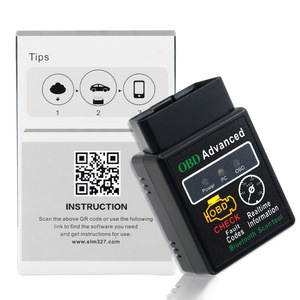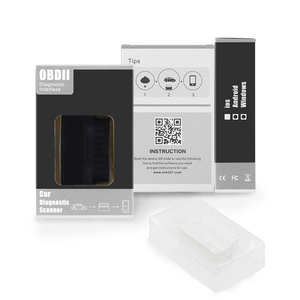(921 products available)

























































































































































































































HH OBD II is a diagnostic tool commonly used in vehicle diagnostics and repair. It connects to the On-Board Diagnostic (OBD) port of a vehicle to access its computer system and retrieve diagnostic trouble codes (DTCs). These codes help identify issues with various components of the vehicle, such as the engine, transmission, or emissions system. HH OBD II scanners can display live data, perform health checks, and provide information about the vehicle's system. They are essential tools for professional mechanics and DIY enthusiasts to diagnose and troubleshoot vehicle problems accurately.
The HH OBD Advanced is a device that plugs into the HH OBD port of a vehicle and communicates with the vehicle's onboard computer system. Different types of HH OBD Advanced exist, and they include the following.
HH OBD scanner
The HH OBD scanner is a device that connects to a vehicle's OBD II port and communicates with the vehicle's onboard computer system. This scanner is designed to diagnose and analyze various aspects of a vehicle's performance and health. It can read and clear diagnostic trouble codes (DTCs), access live data streams from sensors and modules, perform health check reports, and display vehicle information. By connecting the HH OBD scanner, users can access detailed information about the vehicle's systems, helping identify issues, monitor performance, and assist in maintenance and repairs.
HH OBD code reader
The HH OBD code reader is a handheld device that connects to a vehicle's OBD II port and communicates with the vehicle's onboard computer system. This tool is designed to read and interpret diagnostic trouble codes (DTCs) generated by the vehicle's various systems, such as the engine, transmission, and emissions. The HH OBD II code reader allows users to access DTCs, view associated live data, and understand the vehicle's health and performance. It enables users to diagnose issues, monitor real-time data from sensors and modules, and assist in vehicle maintenance and repairs.
HH OBD diagnostic tool
The HH OBD diagnostic tool is a handheld device that connects to a vehicle's OBD II port and communicates with the vehicle's onboard computer system. This tool is designed to diagnose and analyze various aspects of a vehicle's performance and health. It can read and clear diagnostic trouble codes (DTCs), access live data streams from sensors and modules, perform health check reports, and display vehicle information. By connecting the HH OBD scanner, users can access detailed information about the vehicle's systems, helping identify issues, monitor performance, and assist in maintenance and repairs.
Compatibility
The HH Advanced OBD2 scanner is designed to be compatible with a wide range of vehicles, including those with OBD-I and OBD-II systems. This compatibility allows users to access and diagnose issues across various makes and models.
Data Stream
The scanner provides real-time data streams, allowing users to monitor live data from various sensors and modules in the vehicle. This feature helps technicians and mechanics understand the vehicle's performance and make informed decisions when diagnosing issues.
Code Reading and Clearing
The HH Advanced OBD-II scanner can read and interpret diagnostic trouble codes (DTCs) from the vehicle's ECU. It can also clear these codes, resetting the ECU and turning off the check engine light if the underlying issue has been resolved.
Display
Some models of the HH Advanced OBD-II scanners have LCD screens that display live data, DTCs, and other relevant information. This visual feedback helps users understand the vehicle's condition and makes the diagnostic process more intuitive.
Data Logging
Some HH Advanced OBD-II scanners have data logging capabilities, allowing users to record live data and playback for in-depth analysis. This feature is particularly useful for tracking intermittent issues or monitoring performance during specific driving conditions.
Power Supply
The HH Advanced OBD-II scanners receive power through the vehicle's OBD-II port. This eliminates the need for an external power source or batteries, ensuring seamless operation during diagnostics.
Storage
HH Advanced OBD-II scanners have built-in memory for storing DTCs, live data, and other diagnostic information. This storage capability allows users to track historical data and refer to previous diagnostic sessions when needed.
Software Updates
The HH Advanced OBD-II scanner can be upgraded with new diagnostic software and features via the Internet. This ensures that users have access to the latest tools and enhancements, keeping the scanner relevant and effective over time.
Regular maintenance of the HH Advanced OBD-II scanner is essential to ensure optimal performance and accuracy in diagnostics. Here are some general guidelines for maintaining the scanner:
Regular Cleaning
Periodically clean the scanner's exterior, including the screen, buttons, and casing, using a soft, lint-free cloth. Avoid using harsh chemicals or solvents that may damage the device.
Screen Protection
Consider using a screen protector or cover to prevent scratches and damage to the scanner's display. This can help maintain clarity and visibility over time.
Software Updates
Regularly check for software updates for the HH Advanced OBD-II scanner. Manufacturers often release updates to enhance performance, add new features, and improve compatibility with newer vehicles.
Connector and Cable Inspection
Inspect the OBD-II connector and cables for signs of wear, damage, or fraying. Replace any damaged cables or connectors to ensure a reliable connection during diagnostics.
Data Backup
Periodically back up the diagnostic data, including DTCs, live data, and other relevant information, to a computer or external storage device. This ensures data security and allows for easy access to historical diagnostic records.
Storage
When not in use, store the HH Advanced OBD-II scanner in a clean, dry environment away from direct sunlight and extreme temperatures. Avoid placing heavy objects on top of the scanner to prevent physical damage.
Usage Guidelines
Follow the manufacturer's instructions and usage guidelines for the HH Advanced OBD-II scanner. Familiarize yourself with its features, functions, and diagnostic procedures to maximize its effectiveness in vehicle diagnostics.
Choosing the right advanced HH OBD scanner requires careful consideration of several factors to ensure it meets specific diagnostic needs and expectations. Here are some key factors to consider:
By considering these factors, one can choose an HH advanced OBD scanner that meets specific diagnostic needs, enhances efficiency, and provides accurate and reliable diagnostics for vehicle management. It is also important to read reviews, compare different models, and evaluate the needs before making a decision.
Some steps are to be followed when replacing or installing an HH OBD Advanced Scanner.
Check Compatibility
Ensure that the new OBD2 scanner is compatible with the vehicle's make, model, and year.
Turn Off the Vehicle
For safety and to prevent damage to the vehicle's electronics, ensure the car is in the off state before disconnecting the old scanner.
Locate the OBD2 Port
Find the OBD2 port, usually under the dashboard on the driver's side. It is crucial to know this step because, without it, connecting the scanner is impossible.
Remove the Old Scanner
The old scanner is removed by carefully unplugging it from the OBD2 port.
Connect to HH OBD2 Scanner
The HH OBD2 Scanner is connected by plugging it into the OBD2 port, ensuring a secure fit.
Turn On the Vehicle
After starting the vehicle, turn the ignition to the "On" position without starting the engine. This action powers up the scanner and allows it to communicate with the vehicle's systems.
Follow On-Screen Instructions
To set up and use the scanner, follow the instructions and user manual appearing on the screen. This step is very important because it guides the user through the process, making it easier to operate the scanner.
Update Firmware
Connect the scanner to a computer or Wi-Fi network to download and install any available updates. This ensures that the scanner has the most recent features and functions.
Perform Initial Setup
Settings such as selecting the language and configuring other preferences are done once to customize the scanner to the user's needs.
OBD-II Connector Adapter
It is used to connect the scanner to the vehicle's OBD-II port and allows communication between the two.
Data Cable
It connects the scanner to a computer for firmware updates and data transfer.
USB Cable
It is used to charge the device and connect to a computer for updates.
Power Adapter
It powers the scanner when connected to the vehicle's OBD-II port.
HH OBD2 Advanced User Manual
It provides detailed instructions and troubleshooting tips for using the scanner effectively.
Q1: What is the difference between an advanced and a standard OBD-II scanner?
A1: HH-OBD advanced scanners can perform all standard OBD-II functions and have additional capabilities. For instance, they can access manufacturer-specific codes, perform advanced diagnostics, and sometimes even provide live data streaming. This makes them more suitable for deep diagnostic work.
Q2: Can an HH OBD scanner be upgraded?
A2: Yes, in many cases, an HH OBD scanner can be upgraded. Some models allow users to purchase additional licenses or download updates to access new functions or support more vehicles. Always check with the manufacturer or the user manual to see if the model supports upgrades.
Q3: Are HH OBD scanners compatible with all vehicles?
A3: While HH OBD scanners are designed to be compatible with most vehicles manufactured after 1996 (which is the standard OBD-II protocol), there may be exceptions or limitations with some specific models or protocols. It's always good to check the scanner's specifications and the vehicle's details.
Q4: How often should the HH OBD scanner be updated?
A4: Ideally, it should be updated whenever a new version is released and before performing any significant diagnostic work. This ensures access to the latest vehicle models' features, error codes, and improvements.
Q5: Can an HH OBD scanner be used to diagnose hybrid or electric vehicles?
A5: Yes, but with some limitations. Hybrid and electric vehicles use additional systems for energy management. While the HH OBD scanner can diagnose issues related to the OBD-II standard in these vehicles, some hybrid or electric-specific diagnostics may require advanced tools.